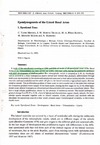Please use this identifier to cite or link to this item:
https://accedacris.ulpgc.es/handle/10553/74817
| DC Field | Value | Language |
|---|---|---|
| dc.contributor.author | Yanes Mendez, C. | en_US |
| dc.contributor.author | Martín Trujillo, J. M. | en_US |
| dc.contributor.author | Pérez Batista, M. A. | en_US |
| dc.contributor.author | Monzón Mayor, Maximina | en_US |
| dc.contributor.author | Martínez Marrero, Antonio | en_US |
| dc.date.accessioned | 2020-10-16T15:52:47Z | - |
| dc.date.available | 2020-10-16T15:52:47Z | - |
| dc.date.issued | 1988 | en_US |
| dc.identifier.issn | 0044-3107 | en_US |
| dc.identifier.other | WoS | - |
| dc.identifier.uri | https://accedacris.ulpgc.es/handle/10553/74817 | - |
| dc.description.abstract | A study of the ependymary covering at (OM and EM) all levels of all ependymal zones of the Basal Areas of the Telencephalon has been caried out [vz(b), vz(e) and vz(f)], during the embryonic, postnatal and adult development of Gallotia galloti. The telencephalic vesicle is iniciated at E-30, its ventricular wall is covered by a thick hoogenous matrix (dorsal and ventral) that gradually differentiates through embryonic development in the mentioned ependymal zones and in four sulcus (sulcus lateralis, terminalis, ventralis and septomedialis) and the adult will give to the lateral ventricle a regionalized aspect, denominated as mosaic. | en_US |
| dc.language | eng | en_US |
| dc.relation.ispartof | Zeitschrift fuer Mikroskopisch-Anatomische Forschung | en_US |
| dc.source | Zeitschrift fuer Mikroskopisch-Anatomische Forschung [ISSN 0044-3107], v. 102 (4), p. 555-572, (1988) | en_US |
| dc.subject | 320103 Microbiología clínica | en_US |
| dc.subject.other | Ependymal Zones | en_US |
| dc.subject.other | Development | en_US |
| dc.subject.other | Basal Areas | en_US |
| dc.subject.other | Telencephalon | en_US |
| dc.subject.other | Lizard | en_US |
| dc.title | Ependymogenesis of the Lizard Basal Areas1. Ependymal Zones | en_US |
| dc.type | info:eu-repo/semantics/Article | en_US |
| dc.type | Article | en_US |
| dc.identifier.isi | A1988P581100004 | - |
| dc.description.lastpage | 572 | en_US |
| dc.identifier.issue | 4 | - |
| dc.description.firstpage | 555 | en_US |
| dc.relation.volume | 102 | en_US |
| dc.investigacion | Ciencias de la Salud | en_US |
| dc.type2 | Artículo | en_US |
| dc.contributor.daisngid | 2042224 | - |
| dc.contributor.daisngid | 1530540 | - |
| dc.contributor.daisngid | 4119642 | - |
| dc.contributor.daisngid | 15494539 | - |
| dc.contributor.daisngid | 10179849 | - |
| dc.description.numberofpages | 18 | en_US |
| dc.utils.revision | Sí | en_US |
| dc.contributor.wosstandard | WOS:MENDEZ, CY | - |
| dc.contributor.wosstandard | WOS:TRUJILLO, JMM | - |
| dc.contributor.wosstandard | WOS:BATISTA, MAP | - |
| dc.contributor.wosstandard | WOS:MAYOR, MM | - |
| dc.contributor.wosstandard | WOS:MARRERO, A | - |
| dc.date.coverdate | 1988 | en_US |
| dc.identifier.ulpgc | Sí | es |
| item.grantfulltext | open | - |
| item.fulltext | Con texto completo | - |
| crisitem.author.dept | GIR IUIBS: Tecnología Médica y Audiovisual | - |
| crisitem.author.dept | IU de Investigaciones Biomédicas y Sanitarias | - |
| crisitem.author.dept | GIR IOCAG: Oceanografía Física | - |
| crisitem.author.dept | IU de Oceanografía y Cambio Global | - |
| crisitem.author.dept | Departamento de Física | - |
| crisitem.author.orcid | 0000-0002-5046-508X | - |
| crisitem.author.orcid | 0000-0002-2376-1561 | - |
| crisitem.author.parentorg | IU de Investigaciones Biomédicas y Sanitarias | - |
| crisitem.author.parentorg | IU de Oceanografía y Cambio Global | - |
| crisitem.author.fullName | Monzón Mayor,Maximina | - |
| crisitem.author.fullName | Martínez Marrero, Antonio | - |
| Appears in Collections: | Artículos | |
WEB OF SCIENCETM
Citations
8
checked on Feb 25, 2024
Page view(s)
160
checked on Mar 15, 2025
Download(s)
191
checked on Mar 15, 2025
Google ScholarTM
Check
Share
Export metadata
Items in accedaCRIS are protected by copyright, with all rights reserved, unless otherwise indicated.
